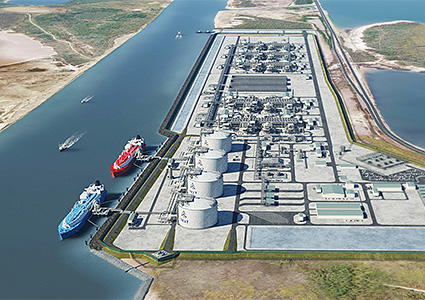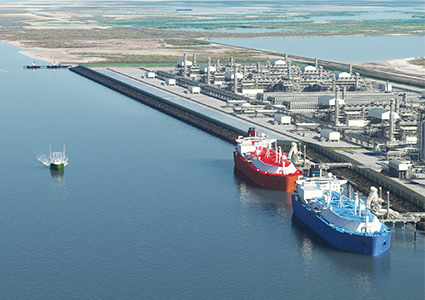Nathan Tungseth, Senior Vice President of LNG at ABB, shares insights into the challenges and opportunities of eLNG
Could you tell me about your career history, and its evolution to your current role?
I graduated from the University of Central Florida with a degree in mechanical engineering, before joining Siemens Westinghouse in their Power Generation division. Working with turbines and generators quickly led me into the oil and gas sector, which is when I moved to ABB. I’ve been with ABB since 2006 and have spent a lot of time in Alaska working on the North Slope and Alyeska Pipeline. In 2011, I moved to Houston where I held several roles, including global account manager for Chevron and managing our oil and gas strategic accounts team. For the past seven years, I’ve been focused on the LNG industry, managing teams to execute major projects around the globe.
Tell me more about the LNG segment at ABB and where your role fits in with the overall business? 
ABB has more than 50 years’ experience in providing electrification, automation and digital solutions to the LNG industry. Our LNG portfolio sits within our Energy Industries division, which is enabling the growth and integration of lower carbon energy systems, while diversifying and optimizing existing systems. I am responsible for developing and leading ABB’s strategy and portfolio management in the LNG industry for both liquefaction and regasification, and onshore and floating.
You spoke at CERAWeek and LNG Export about the future of LNG – can you share the main points of your presentation?
At CERAWeek and LNG Export, I talked about the importance of the world being ready for the unprecedented growth of LNG and, importantly, how we can navigate the challenges and opportunities of eLNG, which we define as all electric LNG.
From late 2024, the global LNG market will see an unprecedented wave of new liquefaction projects coming online. This will be the fastest capacity growth in the LNG industry’s brief history, representing a 40 percent increase in just five years, according to the Institute for Energy Economics and Financial Analysis (IEEFA). The LNG industry is on track to add almost five times as much new liquefaction capacity from 2025-to- 2028 compared to the previous four-year period.
While many advocate for a move away from all hydrocarbons, the reality is that the world needs more electricity. Nearly one eighth of the world’s population still has no access to the reliable power that we, in the more developed world, all take for granted. Yet, areas like Africa are expected to double their population by 2050, which means the demand for electricity will far exceed what we’re able to produce with renewables alone.
Though not perfect, when burned to produce power, natural gas is still around 50 percent cleaner than other traditional methods of energy production. When we electrify LNG production and create eLNG, we’re able to further reduce emissions.
Tell me more about the crucial role of LNG and the importance of electrification of LNG (eLNG) in the energy transition.
The reality is that energy demand will continue to increase as our population grows and developing nations need access to reliable, affordable power. With renewables still expensive and intermittent, developing nations will turn to the lowest cost way to produce reliable power, so we cannot afford to put the brakes on LNG investment and infrastructure, but we do need to ensure that we produce it in the most efficient way possible, which is where eLNG comes into play.
Natural gas, when cooled down to -260 F, shrinks to 1/600th in size and can easily be transported to where it is needed most, overcoming the challenges of global distribution, for cleaner energy production. When we electrify that process, we further eliminate emissions that are required to super chill the natural gas.
In simple terms, eLNG is produced using electric power instead of fossil fuels to operate compressors, pumps, refrigeration units, and other necessary equipment. Gas turbines in the compression trains are replaced with large motors and variable frequency drives. Although more power will be required for this process, this can come from greener, renewable sources like hydroelectric, wind or solar, offset with traditional power from highly efficient combined cycle power plants.
What are the challenges and opportunities of eLNG as a clean energy source?
 Electrifying the LNG process is undoubtedly complex, demanding high power volumes. The process therefore requires a localized power grid study to ensure grid stability and availability. Managing power on this scale is challenging. Large variable frequency drives can be susceptible to fluctuations in the power grid, even when they’re as short as 50 to 150 milliseconds, caused by wind or harsh winter weather. This is where ABB applies both its engineering expertise, and portfolio of automation, electrification and digital solutions to address these issues and help customers maximize the uptime of LNG trains.
Electrifying the LNG process is undoubtedly complex, demanding high power volumes. The process therefore requires a localized power grid study to ensure grid stability and availability. Managing power on this scale is challenging. Large variable frequency drives can be susceptible to fluctuations in the power grid, even when they’re as short as 50 to 150 milliseconds, caused by wind or harsh winter weather. This is where ABB applies both its engineering expertise, and portfolio of automation, electrification and digital solutions to address these issues and help customers maximize the uptime of LNG trains.
That said, the technical challenges are far outweighed by the benefits: specifically, increased efficiency and uptime, with reduced emissions.
Replacing the gas turbine, which operates at around 38 percent efficiency, with a motor that achieves approximately 95 percent efficiency is a significant improvement which has a real impact on energy and emissions. Additionally, the motor can be powered by renewable energy and is not affected by temperature fluctuations. Motors are easier to maintain, reducing maintenance cycles by up to ten days per year, allowing for ten additional days of LNG production. Furthermore, an eLNG facility can recycle the boil-off gas, which would previously have been used to power turbines, to produce more LNG, increasing production by up to four percent.
What steps need to be taken to mitigate supply chain issues, focusing specifically on improving lead times and reducing cost overruns?
Modularization is an effective strategy for managing supply chains, particularly when it comes to improving lead times and reducing cost overruns. We are currently deploying this strategy on several LNG projects, including Shell’s Canada LNG project which is in the commissioning phase and will utilize our modularized electrical systems, as well as Rio Grande which is just beginning construction with our fully integrated automation, electrical and digital systems.
In both projects, we’ve integrated our solutions into modular buildings, which can be constructed in fabrication yards, fully completed, and then shipped to the site.
Can you illustrate eLNG in application – based on an ABB reference?
Our first eLNG project was in Norway, where we were a key partner in developing Equinor’s Hammerfest project, which was completed in 2006. This was the first offshore development in the Barents Sea, marking Europe’s first export facility and the world’s first all-electric LNG facility. The gas to the plant comes from subsea wells located offshore from Hammerfest with no surface installations, connected with a 160-kilometer pipeline from subsea to shore. ABB was responsible for the design, fabrication, integration, supply and commissioning of the plant’s main equipment, and installations of subsea technology. The outcome was a completely integrated automation system controlled from one central location, enabling safer and more reliable operation.
We are also currently collaborating with Glenfarne on its Texas LNG facility in Brownsville, which is nearing its final investment decision. We are supplying all the automation, electrical equipment, and digital solutions in fully modularized buildings. Upon completion, this project will be one of the most efficient eLNG projects in the country.
Looking ahead but more generally, with your expertise, what do you think is next for the LNG sector?
I believe modularization will become increasingly common in LNG designs. It’s important to remember that these projects are multi-billion-dollar undertakings, and many have recently experienced significant cost overruns. The need to mitigate risk and control costs is prompting more projects to rethink their development strategies.
Digital solutions will keep advancing, offering greater flexibility and efficiency at LNG facilities. We already use these solutions to predict equipment failures and optimize maintenance schedules. As digital technologies and AI continue to evolve, we will be able to further refine these processes.
As the benefits of eLNG become more widely recognized, I think we’ll see an increase in greenfield LNG projects adopting electrification. We are also likely to see some existing LNG projects transition to eLNG, particularly in countries like Australia due to stringent emissions requirements.
If there was one critical message, you’d like a reader to take from this piece, what would it be?
LNG is essential for our clean energy future due to its ability to work hand in hand with renewables. However, we must act now to capitalize on the opportunity presented by the electrification of LNG, and drive scale to reduce costs.
Are there any other areas that you consider important for the sector that you’d like to include?
Truly optimized LNG facilities are integrated from the outset. The value of partnerships in gaining momentum on these projects cannot be underestimated. Select key partners early and involve them in the design process to ensure that LNG projects are designed as efficiently as possible, using cohesive technology.
While liquefaction often grabs the headlines, regasification facilities, where LNG is offloaded, deserve equal attention. The energy in supercooled LNG can be harnessed effectively as it is warmed and returned to a gaseous state. This area requires more focus and development to fully leverage its potential.

